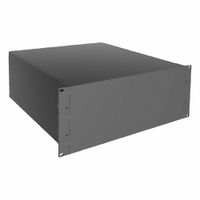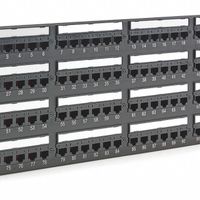Call +(254) 703 030 000 / 751 483 999 / 721 704 777
- Home
- Electrical
- Electrical Boxes Enclosures
- Voice Data Communication Cabinets Accessories
.....Read More
Frequently Asked Questions
What is the purpose of a voice and data communication cabinet?
A voice and data communication cabinet, often referred to as a network or server cabinet, serves as a centralized hub for housing and organizing the essential components of a telecommunications and data network. Its primary purpose is to provide a secure, organized, and efficient environment for the equipment necessary for voice and data transmission.
Firstly, the cabinet offers physical protection for sensitive equipment such as servers, switches, routers, patch panels, and other networking devices. By enclosing these components, the cabinet safeguards them from physical damage, dust, and unauthorized access, thereby enhancing the security and longevity of the equipment.
Secondly, it facilitates efficient cable management. The cabinet is designed with features like cable trays, management panels, and entry points that help in organizing and routing cables neatly. This organization minimizes clutter, reduces the risk of cable damage, and simplifies maintenance and troubleshooting processes.
Thirdly, the cabinet aids in thermal management. It is equipped with ventilation systems, such as fans and perforated doors, to ensure proper airflow and cooling of the equipment. This is crucial in preventing overheating, which can lead to equipment failure and network downtime.
Additionally, the cabinet supports scalability and flexibility. It allows for easy addition or removal of equipment as network demands change, without significant disruption. This adaptability is essential for businesses that anticipate growth or changes in their network infrastructure.
Lastly, the cabinet contributes to compliance with industry standards and regulations. By providing a structured environment for network equipment, it helps organizations meet specific technical and safety standards required in various industries.
In summary, a voice and data communication cabinet is vital for protecting, organizing, cooling, and managing network equipment, ensuring efficient and reliable operation of voice and data communication systems.
How do power distribution units work in network cabinets?
Power Distribution Units (PDUs) in network cabinets distribute electrical power to multiple devices, ensuring efficient and organized power management. They connect to a primary power source and provide multiple outlets for network equipment like servers, switches, and routers. PDUs come in various types, including basic, metered, monitored, and switched, each offering different levels of functionality and control.
Basic PDUs simply distribute power without monitoring capabilities. Metered PDUs display power usage data, helping manage power consumption. Monitored PDUs provide remote monitoring of power usage and environmental conditions, enhancing energy efficiency and reliability. Switched PDUs offer remote control of individual outlets, allowing for power cycling and load balancing.
PDUs are mounted vertically or horizontally within the cabinet, optimizing space and cable management. They support different input and output voltages and currents, catering to specific equipment needs. Some PDUs feature circuit breakers or fuses for overload protection, preventing damage to connected devices.
Advanced PDUs integrate with network management systems, providing real-time data and alerts for proactive maintenance. They support redundancy and failover configurations, ensuring continuous power supply during outages. Environmental sensors can be connected to monitor temperature and humidity, preventing overheating and equipment failure.
Overall, PDUs enhance power distribution efficiency, improve uptime, and facilitate effective power management in network cabinets.
What are the benefits of using patch panels in data communication?
Patch panels offer several benefits in data communication:
1. **Organization**: Patch panels help in organizing cables systematically, reducing clutter and making it easier to manage and identify connections.
2. **Flexibility**: They allow for easy reconfiguration of network connections without the need to rerun cables, facilitating quick changes and upgrades.
3. **Scalability**: As networks grow, patch panels make it easier to add new connections without disrupting existing setups, supporting network expansion.
4. **Maintenance**: Troubleshooting becomes more straightforward with patch panels, as they provide a centralized point to test and diagnose network issues.
5. **Reduced Wear and Tear**: By using patch cords to connect devices to the panel, the wear and tear on the main cables is minimized, extending their lifespan.
6. **Improved Signal Quality**: Patch panels can help maintain signal quality by reducing interference and ensuring proper cable management.
7. **Aesthetic Appeal**: A well-organized patch panel setup enhances the professional appearance of a data center or server room.
8. **Cost-Effectiveness**: While there is an initial investment, patch panels can save money in the long run by reducing maintenance costs and downtime.
9. **Safety**: Properly managed cables reduce the risk of accidents and damage, ensuring a safer working environment.
10. **Standardization**: Patch panels support industry standards, ensuring compatibility and interoperability with various network devices and systems.
How do you choose the right size for a server rack enclosure?
To choose the right size for a server rack enclosure, consider the following factors:
1. **Equipment Size and Quantity**: Determine the total number of devices and their sizes (measured in rack units, or U, where 1U = 1.75 inches). Ensure the rack can accommodate all current equipment and allow for future expansion.
2. **Rack Height**: Standard rack heights range from 24U to 48U. Choose a height that fits your equipment needs and allows for growth. Consider the ceiling height and accessibility for maintenance.
3. **Rack Width**: Standard widths are 19 inches, but wider racks (23 inches) are available for additional cable management space. Ensure the width accommodates your equipment and cabling needs.
4. **Rack Depth**: Depths vary from 24 to 48 inches. Ensure the depth accommodates the deepest equipment, including rear cabling and airflow clearance.
5. **Weight Capacity**: Check the rack’s weight capacity to ensure it can support the total weight of all equipment, including future additions.
6. **Cooling and Ventilation**: Ensure the rack has adequate ventilation options, such as perforated doors or additional fan units, to maintain optimal equipment temperatures.
7. **Cable Management**: Look for racks with built-in cable management features like cable trays, rings, or vertical organizers to maintain a tidy and efficient setup.
8. **Security**: Consider racks with lockable doors and side panels to protect equipment from unauthorized access.
9. **Environment**: Assess the installation environment. For dusty or industrial settings, consider enclosed racks with filters. For office environments, aesthetics and noise reduction may be priorities.
10. **Compliance and Standards**: Ensure the rack meets industry standards (e.g., EIA-310) for compatibility with standard equipment.
By evaluating these factors, you can select a server rack enclosure that meets your current and future needs while ensuring efficient operation and maintenance.
What materials are commonly used for network cabinets and racks?
Network cabinets and racks are essential for organizing and securing networking equipment. The materials commonly used for their construction include:
1. **Steel**: Steel is the most prevalent material due to its strength and durability. It provides robust support for heavy equipment and is often powder-coated to prevent rust and corrosion.
2. **Aluminum**: Lighter than steel, aluminum is used for its corrosion resistance and ease of handling. It is ideal for environments where weight is a concern, though it may not support as much weight as steel.
3. **Plastic**: High-strength plastics, such as polycarbonate or ABS, are used for lightweight and cost-effective solutions. They are suitable for smaller installations or where mobility is required, though they offer less structural support compared to metal.
4. **Glass**: Tempered glass is often used for cabinet doors to allow visibility of equipment while providing a level of protection. It is typically combined with metal frames for added strength.
5. **Wood**: Occasionally used for aesthetic purposes in office environments, wood provides a more furniture-like appearance. However, it lacks the durability and fire resistance of metal and is less common in industrial settings.
6. **Composite Materials**: These are used for specialized applications requiring specific properties, such as enhanced fire resistance or electromagnetic interference (EMI) shielding.
Each material offers distinct advantages and is chosen based on factors like load capacity, environmental conditions, cost, and specific application requirements.
How do you ensure proper ventilation in a server rack?
To ensure proper ventilation in a server rack, follow these key practices:
1. **Rack Placement**: Position server racks in a cool, dry area with adequate space around them. Avoid placing racks against walls or in corners to allow for proper airflow.
2. **Hot and Cold Aisle Configuration**: Arrange racks in a hot aisle/cold aisle configuration. Face the front of the racks towards the cold aisle to intake cool air and the rear towards the hot aisle to expel warm air.
3. **Cable Management**: Organize cables to prevent airflow obstruction. Use cable management arms and vertical cable organizers to keep cables tidy and out of airflow paths.
4. **Blanking Panels**: Install blanking panels in unused rack spaces to prevent hot air recirculation and ensure that cool air is directed through the equipment.
5. **Perforated Doors**: Use racks with perforated front and rear doors to enhance airflow. Solid doors can trap heat and reduce cooling efficiency.
6. **Raised Floor Systems**: If possible, use a raised floor system to distribute cool air from below. Ensure that floor tiles are perforated in the cold aisle for optimal airflow.
7. **Cooling Units**: Implement dedicated cooling systems like CRAC (Computer Room Air Conditioning) units or in-row cooling to maintain optimal temperatures.
8. **Temperature and Humidity Monitoring**: Use sensors to continuously monitor temperature and humidity levels. Place sensors at the top, middle, and bottom of the rack to detect hotspots.
9. **Regular Maintenance**: Clean and maintain cooling equipment and filters regularly to ensure efficient operation. Check for dust accumulation that can impede airflow.
10. **Load Distribution**: Evenly distribute equipment within the rack to prevent hotspots and ensure balanced airflow.
By implementing these strategies, you can maintain efficient ventilation, prevent overheating, and ensure the longevity and performance of your server equipment.
What are the best practices for organizing cables in a network cabinet?
1. **Planning and Design**: Before installation, plan the layout considering future expansion. Use diagrams to map out cable paths and connections.
2. **Labeling**: Clearly label both ends of each cable with unique identifiers. Use durable labels that are easy to read and resistant to wear.
3. **Cable Management Accessories**: Utilize cable management tools such as cable trays, racks, and ducts to keep cables organized and supported.
4. **Color Coding**: Implement a color-coding system for different types of cables (e.g., red for power, blue for data) to quickly identify and troubleshoot connections.
5. **Cable Length**: Use cables of appropriate length to avoid excess slack. Custom-length cables can reduce clutter and improve airflow.
6. **Bundling and Routing**: Bundle cables using Velcro ties instead of zip ties to prevent damage and allow for easy adjustments. Route cables along the sides or back of the cabinet to maintain a clean front view.
7. **Separation of Cables**: Separate power and data cables to minimize electromagnetic interference. Use different paths or trays for each type.
8. **Patch Panels**: Use patch panels to centralize connections and reduce cable clutter. This also simplifies maintenance and reconfiguration.
9. **Airflow Considerations**: Ensure cables do not obstruct airflow within the cabinet. Proper airflow is crucial for cooling and equipment longevity.
10. **Regular Maintenance**: Schedule regular inspections to ensure cables remain organized and in good condition. Update documentation as changes occur.
11. **Documentation**: Maintain detailed documentation of the network layout, including cable paths, labels, and connections, to facilitate troubleshooting and future upgrades.
12. **Training**: Train staff on cable management best practices to ensure consistency and prevent disorganization over time.




